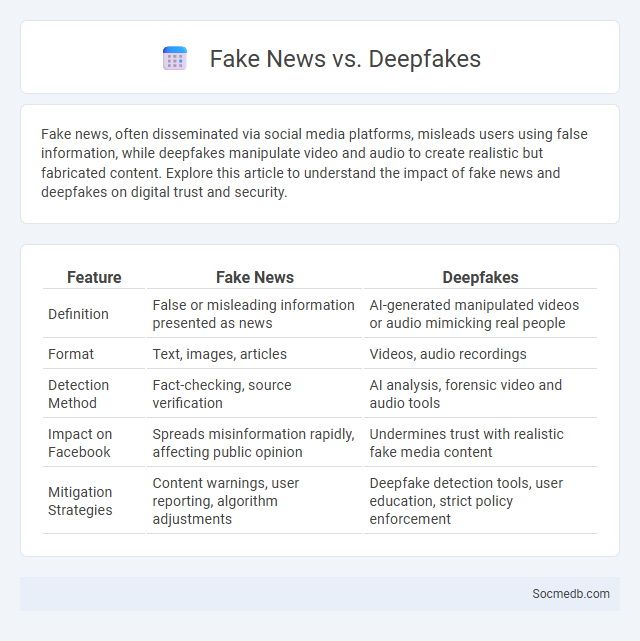
Photo illustration: Fake News vs Deepfakes
Fake news, often disseminated via social media platforms, misleads users using false information, while deepfakes manipulate video and audio to create realistic but fabricated content. Explore this article to understand the impact of fake news and deepfakes on digital trust and security.
Table of Comparison
| Feature | Fake News | Deepfakes |
|---|---|---|
| Definition | False or misleading information presented as news | AI-generated manipulated videos or audio mimicking real people |
| Format | Text, images, articles | Videos, audio recordings |
| Detection Method | Fact-checking, source verification | AI analysis, forensic video and audio tools |
| Impact on Facebook | Spreads misinformation rapidly, affecting public opinion | Undermines trust with realistic fake media content |
| Mitigation Strategies | Content warnings, user reporting, algorithm adjustments | Deepfake detection tools, user education, strict policy enforcement |
Understanding Fake News: Definition and Impact
Fake news refers to deliberately false or misleading information spread through social media platforms to deceive or manipulate public opinion. Its impact includes eroding trust in legitimate news sources, fueling misinformation, and influencing political and social behavior. Understanding how fake news operates helps you critically evaluate content and protect yourself from manipulation.
What Are Deepfakes? A Technological Overview
Deepfakes are synthetic media created using artificial intelligence techniques such as deep learning and generative adversarial networks (GANs) to produce hyper-realistic but fabricated videos or images. This technology manipulates facial expressions, voices, and actions to convincingly depict individuals saying or doing things they never did, posing significant challenges for social media platforms in content verification. Advances in deepfake algorithms continuously improve the realism of manipulated content, prompting the development of sophisticated detection tools to combat misinformation and protect digital authenticity.
Key Differences Between Fake News and Deepfakes
Fake news refers to false or misleading information deliberately spread through social media to deceive readers, often relying on text and images, while deepfakes use advanced AI technology to create realistic but fabricated audio or video content that can manipulate your perception. Fake news typically targets emotions or biases to influence opinions, whereas deepfakes exploit sophisticated visual and auditory manipulation, making detection far more challenging. Understanding these key differences helps you critically evaluate digital content and avoid being misled online.
The Evolution of Misinformation: From Fake News to Deepfakes
Social media platforms have transformed the landscape of misinformation, evolving from simple fake news articles to sophisticated deepfakes that manipulate video and audio content. Advances in artificial intelligence enable the creation of hyper-realistic images and videos, making the detection of false information increasingly challenging. This evolution poses significant risks to public trust, democratic processes, and the spread of accurate information worldwide.
Psychological Effects: How Fake News and Deepfakes Manipulate Audiences
Fake news and deepfakes exploit cognitive biases and emotional triggers to distort your perception of reality, often leading to misinformation and mistrust. These manipulative tactics can cause anxiety, polarization, and impaired decision-making by altering the way your brain processes truth and credibility. Understanding the psychological impact of these digital deceptions is crucial for maintaining mental well-being and critical thinking in the social media age.
Real-World Examples: Fake News and Deepfakes in Action
Fake news on social media platforms has influenced public opinion during major events such as the 2016 US presidential election, spreading misinformation rapidly through viral posts. Deepfakes, increasingly sophisticated AI-generated videos, have been used to create realistic but fabricated content targeting political figures like President Joe Biden, fueling distrust and confusion. Platforms like Facebook and Twitter are investing heavily in detection algorithms and fact-checking partnerships to combat the proliferation of false information and protect democratic processes.
Detection Techniques: Spotting Fake News vs Identifying Deepfakes
Detection techniques for fake news primarily rely on linguistic analysis, fact-checking algorithms, and source verification to assess the credibility of textual content on social media platforms. Deepfake identification utilizes advanced machine learning models, such as convolutional neural networks (CNNs) and temporal inconsistencies detection, to analyze video and audio anomalies that indicate manipulated media. Combining natural language processing (NLP) with forensic algorithms enhances accuracy in distinguishing fabricated information from authentic digital content across various social media channels.
Legal and Ethical Implications of Digital Deception
Digital deception on social media involves legally challenging issues such as identity theft, fraud, and defamation, which can result in severe legal consequences including civil lawsuits and criminal charges. Ethical implications include the erosion of trust, manipulation of public opinion, and violation of privacy, impacting Your digital reputation and relationships. Understanding these risks helps You navigate social media responsibly, ensuring compliance with laws and fostering a trustworthy online environment.
Social Media’s Role in Spreading Fake News and Deepfakes
Social media platforms have become major channels for the rapid dissemination of fake news and deepfakes, amplifying misinformation to millions of users worldwide. Algorithms prioritize sensational content, often disregarding accuracy, which can mislead Your judgment and fuel societal polarization. Combating this issue requires enhanced digital literacy and advanced detection technologies to identify and mitigate the spread of deceptive media on social networks.
Combating Digital Deception: Tools, Strategies, and Future Challenges
Advanced AI-driven tools and algorithms enhance the detection of deepfakes, fake news, and manipulated content on social media platforms, strengthening digital deception defenses. Strategies such as user education, real-time fact-checking, and coordinated platform policies mitigate misinformation's impact on Your online experience. Future challenges involve adapting to increasingly sophisticated digital forgeries, ensuring privacy-preserving verification, and maintaining trust in ever-evolving social media landscapes.
 socmedb.com
socmedb.com